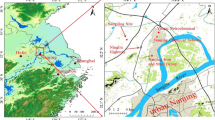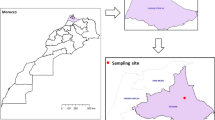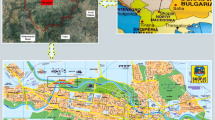Abstract
The U.S. Environmental Protection Agency (EPA) designated 20 urban areas including major cities located in mid-Atlantic US area as being in non-attainment of the new national ambient air quality standards for PM2.5 (particulate matter ≤2.5 μm in aerodynamic diameter). To support the development of effective State Implementation Plans for PM2.5 in the non-attainment area, 24-h integrated Speciation Trends Networks data collected in the mid-Atlantic US urban area were analyzed through the application of the positive matrix factorization (PMF).
A total of 117 to 235 samples and 27 to 29 chemical species collected at the four monitoring sites between 2001 and 2003 were analyzed and six to nine sources were identified. Secondary particles provided the highest contributions to PM2.5 mass concentrations (38–50% for secondary sulfate; 9–18% for secondary nitrate). Potential source contribution function analyses show the potential source areas and pathways of secondary particles contributing to this region, especially the regional influences of the biogenic as well as anthropogenic secondary particles. Motor vehicle emissions contributed 21–33% to the PM2.5 mass concentration. In four sites in southern New Jersey and Delaware, gasoline vehicle and diesel emissions were tentatively separated by different abundances of organic and elemental carbons. The compositional profiles for gasoline vehicle and diesel emissions are similar across this area. In addition, other combustion sources, aged sea salt, and intercontinental dust storms were identified.
Similar content being viewed by others
References
Ashbaugh, L. L., Malm, W. C. and Sadeh, W. Z.: 1985, ‘A residence time probability analysis of sulfur concentrations at Grand Canyon National Park’, Atmospheric Environment 19(8), 1263–1270.
Birch, M. E. and Gary, R. A.: 1996, ‘Elemental carbon-based method for monitoring occupational exposures to particulate diesel exhaust’, Aerosol Science and Technology 25, 221–241.
Bukowiecki, N., Hegedus, F., Falkenberg, G., Gehrig, R., Hill, M., Weingartner, E. and Baltensperger, U.: 2004, ‘Highly time resolved elemental ambient concentrations of railway generated aerosols’, European Aerosol Conference, Budapest, Hungary.
Dockery, D. W., Pope, C. A., Xu, X. P., Spengler, J. D., Ware, J. H., Fay, M. E. and Ferris, E. G.: 1993, ‘An association between air-pollution and mortality in 6 United-States cities’, New England Journal of Medicine 329, 1753–1759.
Draxler, R. R. and Rolph, G. D.: 2003, ‘HYSPLIT (HYbrid Single-Particle Lagrangian Integrated Trajectory) Model access via NOAA ARL READY Website (http://www.arl.noaa.gov/ready/hysplit4.html)’, NOAA Air Resources Laboratory, Silver Spring, MD.
Federal Register: 1997, ‘National Ambient Air Quality Standards for Particulate Matter’; Federal Register 40 CFR Part 50. Vol. 62, No. 138.
Gundel, L. A., Lee, V. C., Mahanama, K. R. R., Stevens, R. K. and Rau, J. A.: 1995, ‘Direct determination of the phase distributions of semi-volatile polycyclic aromatic hydrocarbons using annular denuders’, Atmospheric Environment 29, 1719–1733.
Henry, R. C.: 1987, ‘Current factor analysis models are ill-posed’, Atmospheric Environment 21, 1815–1820.
Hering, S. and Cass, G.: 1999, ‘The magnitude of bias in the measurement of PM2.5 regression arising from volatilization of particulate nitrate from Teflon Filters’, Journal of Air and Waste Management Association 49, 725–733.
Hopke, P. K.: 1985, Receptor Modeling in Environmental Chemistry, Wiley, New York.
Hopke, P. K., Barrie, L. A., Li, S. M., Cheng, M. D., Li, C. and Xie, Y. L.: 1995, ‘Possible sources and preferred pathways for biogenic and non-sea salt sulfur for the high arctic’, Journal of Geophysical Research 100(D8), 16595–16603.
Kim, E., Hopke, P. K. and Edgerton, E.: 2003, ‘Source identification of Atlanta aerosol by Positive Matrix Factorization’, Journal of Air and Waste Management Association 53, 731–739.
Kim, E., Hopke, P. K. and Edgerton, E. S.: 2004, ‘Improving source identification of Atlanta aerosol using temperature resolved carbon fractions in Positive Matrix Factorization’, Atmospheric Environment 38, 3349–3362.
Kim, E. and Hopke, P. K.: 2004a, ‘Source apportionment of fine particles at Washington, DC utilizing temperature resolved carbon fractions’, Journal of Air and Waste Management Association 54, 773–785.
Kim, E. and Hopke, P. K.: 2004b, ‘Improving source identification of fine particles in a rural northeastern U.S. area utilizing temperature resolved carbon fractions’, Journal of Geophysical Research 109, D09204.
Kim, E., Hopke, P. K. and Qin, Y.: 2005, ‘Estimation of organic carbon blank values and error structures of the speciation trends network data for source apportionments’, Journal of Air and Waste Management Association 55, 1190–1199.
Koutrakis, P., Wolfson, J. M., Slater, J. L., Brauer, M. and Spengler, J. D.: 1988, ‘Evaluation of an annular denuder/filter pack system to collect acidic aerosols and gases’, Environmental Science and Technology 22, 1463–1468.
Lee, E., Chun, C. K. and Paatero, P.: 1999, ‘Application of Positive Matrix Factorization in source apportionment of particulate pollutants’, Atmospheric Environment 33, 3201–3212.
Lewis, C. W., Norris, G. A., Conner, T. L. and Henry, R. C.: 2003, ‘Source apportionment of Phoenix PM2.5 aerosol with the unmix receptor model’, Journal of Air and Waste Management Association 53, 325–338.
Liu, D., Wenzel, R. J. and Prather, K. A.: 2003, ‘Aerosol time-of-flight mass spectrometry during the Atlanta Supersite experiment: 1. Measurements’, Journal of Geophysical Research 108(D7), 8426.
Malm, W. C., Sisler, J. F., Huffman, D., Eldred, R. A. and Cahill, T. A.: 1994, ‘Spatial and seasonal trends in particle concentration and optical extinction in the United Sates’, Journal of Geophysical Research 99(D1), 1347–1370.
Maykut, N. N., Lewtas, J., Kim, E. and Larson, T. V.: 2003, ‘Source apportionment of PM2.5 at an urban IMPROVE site in Seattle, WA’, Environmental Science and Technology 37(22), 5135–5142.
Miller, M. S., Friedlander, S. K. and Hidy, G. M.: 1972, ‘A chemical element balance for the Pasadena aerosol’, Journal of Colloid and Interface Science 39, 165–176.
NASA: ‘Earth probe total ozone mapping spectrometer aerosol index: 2001’, available at http://toms.gsfc.nasa.gov/aerosols/aerosols.html.
Paatero, P.: 1997, ‘Least square formulation of robust non-negative factor analysis’, Chemometrics and Intelligent Laboratory Systems 37, 23–35.
Paatero, P., Hopke, P. K., Song, X. H. and Ramadan, Z.: 2002, ‘Understanding and controlling rotations in factor analytic models’, Chemometrics and Intelligent Laboratory Systems 60, 253–264.
Paatero, P. and Hopke, P. K.: 2003, ‘Discarding or downweighting high-noise variables in factor analytic models’, Analytica Chimica Acta 490, 277–289.
Pankow, J. F. and Mader, B. T.: 2001, ‘Gas/solid partitioning of semivolatile organic compounds (SOCs) to air filters. 3. An analysis of gas adsorption artifacts in measurements of atmospheric SOCs and organic carbon (OC) when using Teflon membrane filters and quartz fiber Filters’, Environmental Science and Technology 35(17), 3422–3432.
Poirot, R. L., Wishinski, P. R., Hopke, P. K. and Polissar, A. V.: 2001, ‘Comparative application of multiple receptor methods to identify aerosol sources in northern Vermont’, Environmental Science and Technology 35, 4622–4636.
Polissar, A. V., Hopke, P. K., Paatero, P., Malm, W. C. and Sisler, J. F.: 1998, ‘Atmospheric aerosol over Alaska 2. Elemental composition and sources’, Journal of Geophysical Research 103(D15), 19045–19057.
Polissar, A. V., Hopke, P. K. and Poirot, R. L.: 2001, ‘Atmospheric aerosol over Vermont: Chemical composition and sources’, Environmental Science and Technology 35, 4604–4621.
Pope, C. A., Thun, M. J., Namboodiri, M. M., Dockery, D. W., Evans, J. S., Speizer, F. E. and Heath, C. W.: 1995, ‘Particulate air pollution as a predictor of mortality in a prospective study of U.S. adults’, American Journal of Respiratory and Critical Care Medicine 151, 669–674.
Rolph, G. D.: 2003, ‘Real-time Environmental Applications and Display sYstem (READY) Website (http://www.arl.noaa.gov/ready/hysplit4.html)’, NOAA Air Resources Laboratory, Silver Spring, MD.
RTI: 2004, ‘Quality assurance projects plan chemical speciation of PM2.5 filter samples http://www.epa.gov/ttn/amtic/files/ambient/pm25/spec/rtiqap.pdf, Research Triangle Park, NC.
Schwartz, J., Dockery, D. W. and Neas, L. M.: 1996, ‘Is daily mortality associated specifically with fine particles?’, Journal of Air and Waste Management Association 46, 927–939.
Shah, S. D., Cocker, D. R., Miller, J. W. and Norbeck, J. M.: 2004, ‘Emission rates of particulate matter and elemental and organic carbon from in-use diesel engines’, Environmental Science & Technology 38(9), 2544–2550.
Song, X. H., Polissar, A. V. and Hopke, P. K.: 2001, ‘Source of fine particle composition in the northeastern U.S.’, Atmospheric Environment 35, 5277–5286.
Tolocka, M. P., Solomon, P. A., Mitchell, W., Norris, G. A., Gemmill, D. B., Wiener, R. W., Vanderpool, R. W., Homolya, J. B. and Rice, J.: 1999, ‘East versus west in the US: Chemical characteristics of PM2.5 during the winter of 1999’, Aerosol Science and Technology 34, 88–96.
Watson, J. G., Chow, J. C., Lowenthal, D. H., Pritchett, L. C. and Frazier, C. A.: 1994, ‘Differences in the carbon composition of source profiles for diesel and gasoline powered vehicles’, Atmospheric Environment 28(15), 2493–2505.
Watson, J. G. and Chow, J. C.: 2001a, ‘Source characterization of major emission sources in the Imperial and Mexicali Valleys along the US/Mexico border’, The Science of the Total Environment 276, 33–47.
Watson, J. G., Chow, J. C. and Houck, J. E.: 2001b, ‘PM2.5 chemical source profiles for vehicle exhaust, vegetative burning, geological material, and coal burning in northwestern Colorado during 1995’, Chemosphere 43, 1141–1151.
Author information
Authors and Affiliations
Corresponding author
Rights and permissions
About this article
Cite this article
Kim, E., Hopke, P.K. Identification of Fine Particle Sources in Mid-Atlantic US Area. Water Air Soil Pollut 168, 391–421 (2005). https://doi.org/10.1007/s11270-005-1894-1
Received:
Accepted:
Issue Date:
DOI: https://doi.org/10.1007/s11270-005-1894-1




